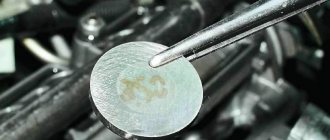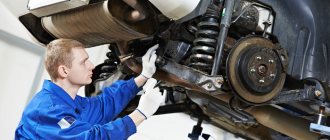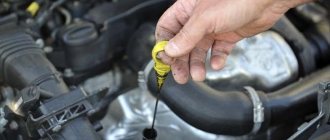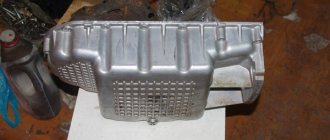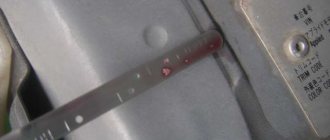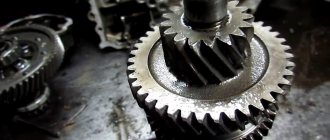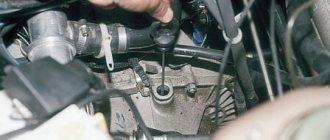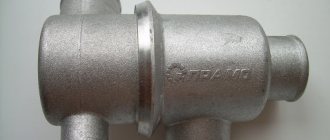04/28/2021 3,608 Consultation with a specialist
Author: Ivan Baranov
Hello! Gearbox 8 with a small divider. Vibration in 2-4.6-8 gears. Please tell me what this could be connected with! (Sergey)
Good day, Sergey. Any vibrations in the gearbox are somehow related to problems in the operation of the unit.
[Hide]
Causes of automatic transmission vibration
An automatic transmission is a complex device consisting of several interconnected components. It contains bearings, valves, gears and other elements that are in motion and capable of producing vibration if there is a problem. Improper installation of an automatic transmission can cause similar symptoms.
Schematic structure of a typical automatic transmission:
Box vibration manifests itself as a beating transmitted to the automatic transmission selector and body, felt by the driver. The beat can be of varying intensity and appear in different situations:
- idling;
- when accelerating a car;
- vibration when engaging reverse gear of the automatic transmission;
- when changing gears;
- when stopping or starting to move for a short time, if you press the brake in position D or “reverse”.
Important: vibration of the box is not always associated with problems with the automatic transmission itself; sometimes this phenomenon is associated with a malfunction of the chassis, engine, ignition, low-quality fuel, wheel imbalance, etc.
Vibration when turning on the automatic transmission and operation of the automatic transmission
At the beginning of the comments, a question was asked about the vibration of the interior and the entire car when turned into position D. I didn’t notice this on mine for a long time, but in cold weather I listened and really felt a slight tremor. After searching on the Internet, I found an answer that I think will reassure many and give a complete understanding of why this is happening.
Most automatic transmissions fail in winter, due to several reasons. The first reason is the negative ambient temperature, which has a detrimental effect on the resources of the automatic transmission when the car starts moving after starting the engine in the cold, the second is the slipping of the car’s wheels on ice when starting to move or the wheels slipping in place when the car is stuck.
When preparing your car for winter use, which basically boils down to changing wheels, engine oil and filter, it’s worth preparing your automatic for winter. If a scheduled replacement of the hydraulic fluid and filter in an automatic transmission is due, then you should not wait for the onset of cold weather, it is better to change everything in advance.
What happens in winter? During the operation of an automatic transmission throughout the year, the hydraulic fluid (ATF) loses its performance properties, such as: resistance to oxidation, constant viscosity at different temperatures, resistance to foaming, and a number of others, (ATF) ages, and ages faster in the summer - when operating the machine at + 30 degrees Celsius and above, in urban driving conditions, with frequent stops at traffic lights, but there’s no point in talking about traffic jams. Also, the hydraulic fluid is contaminated with wear products of friction and steel discs, automatic transmission bushings, respectively, most of this wear remains in the automatic transmission filter and on the magnets in the pan, the finest suspension accumulates in the automatic transmission hydraulic control unit. With the onset of cold weather, condensation begins to form, and not only in the carburetor :-), but also in the automatic transmission housing, something evaporates, and something remains in the automatic transmission filter. We start the car at -20 or -30, warm up the engine, but we never warm up the automatic transmission in park or neutral, and at this time the automatic transmission filter has already successfully frozen overnight, the ATF is thick, viscous, there is a catastrophic lack of pressure and the bushings are working in the oil starvation, a few minutes while we warm up the engine. We begin to move away, the automatic transmission shifts to 2.3 gear, and the hydraulic fluid has not yet warmed up to operating temperature, the automatic transmission filter is dirty, clogged with wear products, there is not enough output pressure, and the friction discs begin to burn. . . The service life of the automatic transmission is long, but we are successfully reducing it to 50,000 km. Another option: the ATF is thick, the pressure on the filter is high, it pushes through the filter, tears out a piece of the filter element, the bypass valve and pressure relief valve cannot cope, they are frozen and jammed, and the pressure begins to squeeze out all the gaskets, rubber seals and rings.
RECOMMENDATION #1
If the hydraulic fluid with a filter in the automatic transmission has not been changed for more than 30,000 km of the car's mileage, and a cold winter sets in, I recommend REPLACING THE AUTOMATIC TRANSMISSION FILTER and ATF!!! If the ATF has a brown, dark, black color, or maybe inclusions of black, metal, aluminum particles, CHANGE, regardless of the mileage of the car, however, if it is not too late.
RECOMMENDATION #2
If we start the car in the cold, let the engine warm up a little, then begin to warm up the automatic transmission. Press the brake pedal and set the gear shift range selector lever to “L” (you can, of course, also “D” or “R”). If the engine stalls, let the engine warm up more. After switching on the gear, vibration appears, the internal combustion engine may “start up”, this is due to intense friction of the hydraulic fluid in the automatic transmission torque converter due to the fact that the pump wheel rotates and the turbine wheel is braked until you turn off the gear or lower foot off the brake, hydraulic fluid friction occurs between the pump and turbine wheels, and the ATF molecules begin to heat up intensely. The automatic transmission pump constantly feeds the torque converter, and the ATF is drained from the torque converter into the automatic transmission sump. How long should you keep your foot on the brake? It all depends on the ambient temperature and the volume of ATF in the automatic transmission. The colder and larger the automatic transmission, the longer, at -20 degrees Celsius we warm it up for 5-8 minutes.
RECOMMENDATION #3
Start of movement: - set the gear shift range selection lever to “L” and without pressing more than 1/3 of the accelerator (gas) pedal, drive 50-100 meters, then move the lever to 2, then 3 and “D”. During this short time, the hydraulic fluid will have time to make several passes through the automatic transmission, the warm fluid will enter the gear clutches, and since the speed is low and the engine speed is low, the process of engaging the clutches will take place in a gentle, optimal mode, without wear of the friction elements.
If you have an electronic-hydraulic automatic transmission control system, then most likely you have a winter automatic transmission control program. There are buttons, usually located next to the gearshift lever or on the instrument panel. Button designations for the winter program: “WINTER”, “W”, “SNOW”, “*”, “HOLD”. When this button is pressed, the automatic transmission begins to work according to an algorithm that eliminates wheel slipping when the car starts from a standstill, in other words, the operation of 1st gear is eliminated altogether and the car’s movement begins immediately from 2nd gear, and gear shifting to the highest gear occurs at minimum engine crankshaft speed. All loads during the start of movement are taken over by the torque converter, which smoothes out and absorbs all jerks, the automatic transmission hydraulic fluid heats up more than in normal driving mode, so in the summer the winter program cannot be used (the child pressed the button, but the mother has no need... , for example, my child not only pressed the button, but managed to pull the lever while moving).
RECOMMENDATION #4
Concerns those who like to put pressure on the sneaker. Do not press the accelerator (gas) pedal sharply if the road surface is not uniform in winter, for example, it has areas of dry asphalt mixed with areas covered with ice. Try to overcome this section without speeding up. The fact is that the wheels of your car, when they hit an area with ice, can slip in place, the automatic transmission switches to a higher gear, and at this time, the wheels hit dry asphalt, the automatic transmission abruptly switches to a lower gear, and this can happen more than once times in a short period of time, while the transmission experiences enormous loads. As a result, the brake band in the automatic transmission may break and you will lose 2-4 gears. This applies primarily to all automatic transmissions of MITSUBISI, HYUNDAI, as well as some CHRYSLER and FORD automatic transmissions, for example CD4E on Mondeo, it is also installed on MAZDA 626 -94Up.
RECOMMENDATION #5
WHEN THE CAR IS STUCK. Before pressing the floor with a slipper, set the shift range selector lever to position “1” or “L”; “R” is not recommended due to the larger gear ratio. Now you can try to drive out, but press the accelerator (gas) pedal no more than 1/3 of the entire stroke. If you try to drive in range “D” when the car is stuck and press as hard as you can on the pedal, the following happens. One wheel, as a rule, is blocked, the second one rotates faster and faster, the automatic transmission switches to 2nd - 3rd - 4th gear, but the load is still heavy. Try to get out of the swamp in 4th gear using simple mechanics, what will happen? That's right, at best the clutch will burn out, at worst the basket will fall apart. Similarly, on an automatic machine, the friction discs will burn out; sometimes they don’t just burn out, but melt to each other along with the support disc; the temperature in the area of their contact, in such cases, was 600 degrees Celsius. What do you think will happen to the hydraulic fluid in the machine? Its rapid aging can knock it out through the automatic transmission breather two! The load on the differential and the main gearbox is also large, you can easily “plant” them, I’m generally silent about the planetary gearset, especially when the engine is 3.5L and beyond, you can press so hard that the splines on the planetary gearbox will simply blow away, beauty, min 350$. . .for a piece of hardware + work.
Information taken from the site https://akppinfo.narod.ru/Expl_AKPP/Zimoi/Zimoi.html
Reasons related to the box
Vibration can cause some automatic transmission problems:
- Deformation of the input shaft of the box.
Sample of input shaft:
A change in the geometry of the shaft, which has occurred for some reason, can provoke vibration and beating felt by the driver. The box will vibrate during acceleration, regardless of the currently active gear.
- Insufficient oil level.
A lack of transmission fluid causes oil starvation of the elements; automatic transmissions are especially sensitive to the amount of oil. If it is not enough, the transmission components wear out at an accelerated pace; over time, the automatic transmission begins to vibrate, “push”, grind, until it eventually fails.
- Poor quality oil.
The wrong type of fluid poured into the box, oil wear and contamination with foreign particles can also cause the box to “kick” and vibrate. In addition, similar symptoms sometimes appear when driving in cold weather on an unheated gearbox, when the oil is viscous and does not provide proper performance characteristics.
- Worn out box cushions.
We explore the engine compartment and engine sounds
If you determine that the vibration is coming from under the hood, most likely the cause will be improper operation of the engine or the mounting points of vibration-loaded elements.
Problems related to internal combustion engines:
- Engine tripping. Many car owners have encountered a situation where, when accelerating or driving under tension, the engine begins to shake, and the thrust is much weaker than before. In this case, comprehensive engine diagnostics is necessary. The problem may be hidden in the ignition system: worn-out spark plugs, GDP, module and other elements, the malfunction of which leads to misfire in one or several cylinders at once. Possible burnout of valves, insufficient fuel pressure, etc. There are so many reasons that the topic deserves separate detailed consideration.
- Engine support cushions. Vibration during acceleration will appear because an increase in engine speed increases the centrifugal forces acting on the car body. When you sharply press the accelerator pedal to the floor, noticeable shocks may be observed. Made of hard rubber, even new cushions will cause vibrations.
Gearbox and clutch drive
It is also worth paying attention to the mounting locations of the gearbox. Perhaps the reason may be hidden inside the gearbox housing. In the case of a manual transmission, for a more accurate diagnosis, you should pay attention to the factors causing vibration or beating. If symptoms only appear at a certain speed limit, try driving it alternately in different gears. For example, if vibration is noticeable at 70 km, first engage 2nd gear, then 3rd (of course, if the gearbox ratios allow). This way, you can more accurately identify the transmission components that cause vibration.
If there is deformation of the input shaft in the gearbox, vibrations will be noticeable when accelerating in any gear.
An unbalanced flywheel can also cause the symptoms discussed. At the same time, it is worth paying attention to the clutch and release bearing.
If the car has an automatic transmission, check the oil level and condition. An indicator that is too low can cause shocks and vibrations.
Exhaust system
Improper mounting of the engine exhaust system can lead to noticeable vibrations in certain engine operating ranges.
Reasons beyond the automatic transmission
Quite often, vibration that appears to be coming from the automatic transmission is not. Vibrations from the engine can be transmitted to the body (and box) if its mountings have become unusable. For example, if there is vibration in the automatic transmission when you engage a gear, this may indicate the engine mounts (but also wear/displacement of the automatic transmission mount).
Another common reason is poor quality fuel. If you pour low-quality gasoline into a modern injection engine, it can quickly clog one or more injectors, as a result - the engine begins to “tweak”, and engine vibration will appear when the automatic transmission is engaged. In this case, vibration when accelerating may disappear because the pressure in the fuel line increases. The fuel filter becomes clogged, with a similar effect.
Similar manifestations are caused by faulty ignition coils, spark plugs or armored wires: the fuel combustion cycle is disrupted, the engine sneezes and troits. A characteristic symptom is a drop in speed and shaking when switching to mode D, vibration when engaging the reverse gear of the automatic transmission from idle. The engine does not have enough power, and it begins to “shudder” noticeably, transmitting the impulse to the body and gearbox.
Balancing required
Runout on the steering wheel and car body with increasing speed is inevitable if the wheels are not balanced. The uneven distribution of mass relative to the center of the wheel rim leads to such consequences. The action of multidirectional centrifugal forces leads to the appearance of multi-frequency oscillations, which are felt as a beating in the car interior.
The problem may manifest itself in the following cases:
- Installing new tires. Replacing tires on rims or putting new rims on old tires must be accompanied by balancing. Even for the manufacturer, achieving ideal weight distribution and geometric parameters seems to be an extremely difficult task.
- Loss of old balancing weights. This is especially true for light alloy wheels, where the weights are glued to the inside of the wheel. Let us remember that in the case of stamped rims, the weights are placed in the outer shoulder of the rim.
- Deformation of the rubber or disk due to falling into a deep pothole, a strong impact with the curb and other similar obstacles.
- Natural imbalance. During operation, any wheel will lose its established balance. It is recommended to carry out scheduled balancing every 15-20 thousand km.
CV joint
Another breeding ground for imbalance is often the constant velocity joint. It serves as a device for the movable articulation of the drive shaft and gearbox, which allows the transmission of torque in different planes (internal CV joint). At the other end of the drive shaft for articulation with the hub (outer CV joint).
Most often, the cause of vibrations lies precisely in the internal hinge. In the case of a tripod-type design, wear out of the rollers is observed. In especially severe cases, the bearing may even “fall apart”. It is also possible to produce a tripod glass.
A similar malfunction can be caused by a torn boot, which can no longer protect against dirt and dust flying from under the wheels. Therefore, periodically check the integrity of the CV joint boots.
Drive shaft
It will be worth mentioning that a car with a drive of irregular geometric shape is guaranteed to experience vibration when accelerating. A bent drive shaft will not only rotate around its axis, but also provoke parasitic centrifugal forces. As a result, the car will receive additional vibrations as it accelerates.
Cardan
The problem is typical for cars with rear-wheel drive and all-wheel drive. Wear of the cardan joint leads to vibration during acceleration. If you encounter a similar problem, pay attention to the following elements:
- crosses;
- suspension bearing;
- directly to the driveshaft. An unbalanced cardan will lead not only to beating, but also to subsequent destruction of the joints.
There were cases when the cause of runout at speed was play in the gearbox shank. This also needs to be paid attention to.
Causes of car vibration - why it occurs and what to do
In modern realities, the car has become so firmly established in everyday life that most of us simply cannot imagine working or relaxing without it. Therefore, when minor car malfunctions arise, and even more serious breakdowns, such as constant or intermittent vibration when driving or while the car is standing, when braking or at a certain speed, we immediately go to a car service center.
But it is possible to diagnose a breakdown and find out the causes of car vibration without special skills or equipment. You just need to take into account everything that is written below, because this is the result of many years of practice of a universal master working at a specialized service station that identifies and eliminates these breakdowns.
Vibration when the car is parked
One of the most annoying problems is vibration at idle. You are not going anywhere, the engine is just warming up, and the started car “jumps” so much that you just want to get out. Whereas if you are already driving, but slow down, for example, at a traffic light or in front of a pedestrian crossing, you immediately want to turn off the engine: the vibration is unbearable.
There are actually several reasons, and most of them can be identified by computer engine diagnostics:
- Candles. Old, worn-out, wrong-size, no-name analogues of low quality, or even outright fakes. An auto electrician will help you determine whether they require replacement or not.
- High voltage and other wires. Similar to candles: you can buy something you don’t need even in a large specialized store with a good reputation. Whereas if you prefer to buy up at the car market, the probability increases significantly.
- Injectors. The cost of new ones can seriously lighten your wallet: but increasingly, they are the main reason why a running car vibrates.
- Compression. It should not only be sufficient, but also uniform in all cylinders. Otherwise, the car will twitch at low speeds and consume more fuel than usual.
- Finally, the timing belt/chain is not installed correctly. At the same time, the level of vibration directly depends on the displacement, by one tooth/link or several: the more, the higher it is.
The solution is to replace faulty parts or visit an experienced technician. Because it can easily determine the cause of vibration and eliminate it.
Car vibration while moving
Considering the quality of our secondary roads, it is not always possible to determine a future serious breakdown based on the primary signs of a malfunction, since the causes of vibration at medium and high speeds can be:
- Tires when the outside of the tire looks smooth, without cuts or bumps, and the cord has internal deformation. And even dismantling the rubber will not show this. There is only one answer - replacing the tires.
- The same is true when installing used tires. Vibration cannot be avoided, even re-balancing does not help.
- The disks themselves. Both steel and light alloy: anyone can bend during impact/use. But if iron and forged ones can simply be rolled on a special rolling machine, then the latter will most likely crack from this.
- Engine/gearbox mounts. They can dry out and crack over time without being clamped. Likewise, if the mounting brackets for these units are bent or even broken. And the result is the same - vibration of the car when driving.
- Or when the driveshaft in rear- and all-wheel drive cars is bent, damaged or faulty. A lift or pit plus the experienced eye of a master will make it easy to diagnose this breakdown.



